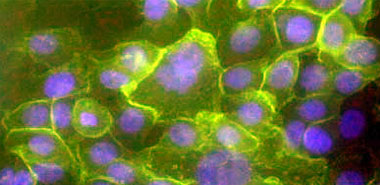
导读:近期(2010年6月2日)国际学术期刊Stem Cells发表了以裴钢研究组为主完成的最新研究成果:小分子化合物通过E-cadherin 蛋白加速重编程过程。
细胞重编程是指已经分化的细胞重新获得分化多能性的过程。诱导多能干细胞即iPS细胞是通过向体细胞中以病毒方式导入外源的四个转录因子Oct3/4,Sox2,c-Myc及Klf4而获得,具有与胚胎干细胞(ESC)相似的形态和表观遗传特征,更重要的是,二者具有相似的分化能力,即分化的全能性。iPS细胞的出现使得无伦理争议的病人特异性的干细胞获得成为可能,而由病人特异性的iPS细胞分化得到的特异性前体细胞和成熟细胞即可应用在组织器官移植治疗、基因治疗、药物筛选模型的建立、以及特异疾病分子机制的研究等多方面。了解重编程过程复杂的分子机制有利于开发更加安全和有效的iPS诱导方法。
在已有的iPS细胞诱导体系的基础上,裴钢等研究组此项研究工作发现细胞粘附相关分子E-cadherin蛋白在iPS形成过程中起着重要作用。E-cadherin蛋白的表达水平在细胞重编程过程的早期即开始上调;在完全重编程的iPS细胞中存在着与ES细胞中相同的由E-cadherin蛋白介导的细胞-细胞连接,下调E-cadherin的表达会降低iPS形成效率,反之,过表达E-cadherin能够促进iPS形成效率。在重编程过程中过表达E-cadherin而得到的iPS细胞具有和ES细胞一样的分化全能性。进一步,研究人员筛选得到了两种能够通过促进E-cadherin蛋白表达而提高iPS细胞诱导效率的小分子化合物,从而提供了优化iPS细胞诱导效率的新策略。
该项工作得到了国家科技部、国家自然科学基金委及中国科学院经费支持。
生物谷推荐原文出处:
STEM CELLS DOI:10.1002/stem.456
Embryonic Stem Cells/Induced Pluripotent Stem Cells
Taotao Chen 1, Detian Yuan 1, Bin Wei 1, Jing Jiang 1, Jiuhong Kang 1 2, Kun Ling 3, Yijun Gu 1, Jinsong Li 1, Lei Xiao 1, Gang Pei 1 2 *
1Laboratory of Molecular Cell Biology, Institute of Biochemistry and Cell Biology, Shanghai Institutes for Biological Sciences, Chinese Academy of Sciences, Shanghai 200031, China
2Shanghai key laboratory of signaling and disease research, School of Life Sciences and Technology, Tongji University, Shanghai 200092, China
3Department of Biochemistry and Molecular Biology, Mayo Clinic Cancer Center, Rochester, MN 55902, USA
The low efficiency of reprogramming and genomic integration of virus vectors obscure the potential application of induced pluripotent stem (iPS) cells; therefore, identification of chemicals and cooperative factors that may improve the generation of iPS cells will be of great value. Moreover, the cellular mechanisms that limit the reprogramming efficiency need to be investigated. Through screening a chemical library we found that two chemicals reported to upregulate E-cadherin considerably increase the reprogramming efficiency. Further study of the process indicated that E-cadherin is upregulated during reprogramming and the established iPS cells possess E-cadherin-mediated cell-cell contact, morphologically indistinguishable from ES cells. Our experiments also demonstrate that overexpression of E-cadherin significantly enhances reprogramming efficiency, whereas knockdown of endogenous E-cadherin by shRNA reduces the efficiency. Consistently, abrogation of cell-cell contact by the inhibitory peptide or the neutralizing antibody against the extracellular domain of E-cadherin compromises iPS cell generation. Further mechanistic study reveals that adhesive binding activity of E-cadherin is required. Our results highlight the critical role of E-cadherin-mediated cell-cell contact in reprogramming and suggest new routes for more efficient iPS cell generation.







